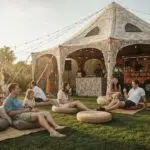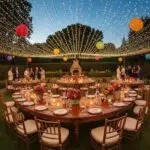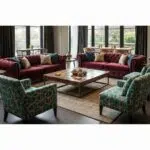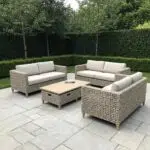Estimating tableware for an event may seem like a simple task, but getting it wrong can mean a shortage of essentials mid-service or an overflow of unused rentals that strain the budget. Whether you’re planning a formal wedding, a corporate luncheon, or a cocktail reception, accurate tableware estimation is a critical behind-the-scenes element that directly impacts guest experience. From the number of attendees and meal type to the venue layout and service style, every event variable influences what you’ll need and how much. This guide breaks down the key factors to consider when calculating your event’s tableware, ensuring a smooth, elegant, and well-equipped celebration.
Key Takeaways
- The total number of guests is the foundation for calculating all tableware quantities.
- The required items are affected by event type, service style, and course count.
- A 5–10% buffer accounts for breakage, lost items, or unexpected guests.
- Menu planning helps identify specialty items like soup bowls or cocktail glasses.
- Venue layout and furniture determine linen sizes, glassware types, and decor add-ons.
- Choosing a professional rental partner ensures smooth execution and inventory coverage.
What Are the Key Factors to Consider When Estimating Tableware for Events?
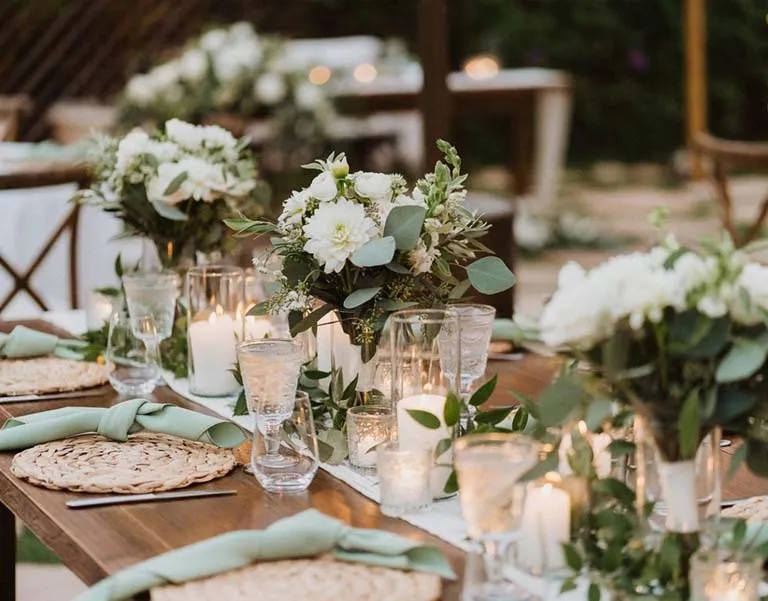
Accurate estimation begins by defining each variable that influences tableware needs: the number of attendees, event format, menu structure, and venue layout. These factors work together to determine the exact counts of plates, bowls, forks, knives, spoons, wine glasses, and linens needed for seamless service.
How Does Guest Count Impact Tableware Requirements?
Guest count drives baseline quantities, each person typically uses one dinner, one salad, and one dessert plate. Adding a 5–10% buffer handles unexpected attendees or breakage. Larger crowds increase the risk of shortages, so it is important to adjust buffer rates based on group size.
Why Does Event Type Influence Tableware Needs?
Event type dictates the number of courses and style of service. Buffet receptions may require extra side-dish and bread plates, while plated banquets call for formal cutlery settings and charger plates. Cocktail parties need cocktail glasses, champagne flutes, and small appetizer plates rather than full dinnerware sets.
How Does Menu Planning Affect Tableware Estimation?
Menus with several courses—such as salad, entrée, dessert, and bread—demand distinct plates and specialized cutlery. Buffets may need extra serving dishes and bowl rentals for side salads or pasta salads. Identifying every course ensures complete coverage of tableware.
What Role Does Venue and Setup Style Play in Tableware Planning?
The venue and setup style impact tablecloth sizes, charger plates, and flatware choices. Formal tent dining requires tablecloths sized with drop lengths, while high-top cocktail settings emphasize beer mugs, wine glasses, and cocktail glasses over full place settings.
How Do You Calculate the Number of Plates, Cutlery, and Glassware Needed?
Calculations rely on standardized per-person formulas adjusted for event specifics and buffer percentages. Breaking down each category allows planners to generate accurate line items for inventory or rental.
How Many Plates Per Person Are Needed for Different Event Types?
- Plated dinners: 3 plates per person (dinner, salad/appetizer, dessert)
- Buffet lunch/dinner: 2 plates per person (dinner and side-dish/bread) plus 1 extra per 10 attendees
- Cake-and-coffee receptions: 1 dessert plate per person plus 1 extra per 15 guests
A 5–10% buffer ensures plates remain available during peak service.
What Is the Best Way to Estimate Cutlery Needs for Your Event?
Begin with a basic setting per guest—fork, knife, spoon—and add specialty utensils for soup, dessert, and butter as needed. Multiply the setting by guest count and add 10% for breakage. For buffet lines, include extra serving spoons and forks.
How to Determine Glassware Quantities Based on Drink Menu and Guest Count?
Estimate drink type ratios (e.g., 60% wine, 30% beer, 10% cocktails) and calculate as follows:
- Wine: 1.5 glasses per wine-drinking guest
- Beer: 1.2 mugs per beer order
- Cocktails: 1.3 glasses per cocktail order
Also, include an extra champagne flute per guest and a 10% spare for breakage.
How Should Linen and Serving Dishes Be Accounted for in Tableware Estimates?
Measure the dimensions of each table to choose the correct tablecloth and napkin sizes. For serving dishes, allocate one bowl or platter per side dish station, with extras for buffet replenishment.
How Can You Use Tools and Techniques to Improve Tableware Estimation Accuracy?
Calculators and visual guides reduce manual errors and align expectations between planners and rental teams. Expert-recommended methods help further mitigate shortages.
What Is a Tableware Calculator and How Does It Help?
A tableware calculator is an interactive tool that uses inputs—guest count, courses, drink menu, event type—to output precise quantities of plates, cutlery, glassware, linens, and serving pieces while automating buffer calculations and estimates for rentals.
How to Use Table Setting Guides to Visualize Tableware Needs?
Table setting diagrams illustrate placements for charger plates, dinner plates, utensils, glassware, and napkins. These visuals help ensure the correct number and arrangement of tableware before ordering.
What Expert Tips Can Prevent Tableware Shortages at Events?
- Confirm the final guest count 72 hours before the event and update orders accordingly.
- Order 10% extra items to cover breakage, delays, or unexpected guests.
- Group rentals by package (e.g., cake-serving sets, cocktail collections) to streamline logistics.
- Coordinate delivery and pickup times to avoid shortages or overages during the event.
How Do Different Event Types Affect Tableware Estimation Strategies?
Different events have unique tableware demands. Weddings require formal glassware and charger plates, corporate events favor simplicity, and cocktail events focus on barware and small plates.
How to Estimate Tableware Needs for Weddings?
Weddings typically feature plated dinners, toasts, and cake service. Plan for three plates per guest, formal cutlery, wine glasses (both white and red), champagne flutes for toasts, and dessert forks for cake. Adding charger plates and bread plates can elevate the aesthetic.
What Are Tableware Requirements for Corporate Events?
Corporate luncheons often use buffet service or boxed meals. Estimate two plates per person (entrée and side dish) and provide coffee mugs or water glasses, keeping the flatware simple to streamline service and cost.
How to Plan Tableware for Birthday Parties and Cocktail Events?
Birthday buffets and cocktail receptions call for appetizer plates, small bowls for dips, cocktail glasses, and beer mugs. Plan for one cocktail glass per guest (with a 10% buffer), three appetizer plates per person, and additional napkins for high turnover.
What Are the Best Practices to Avoid Tableware Shortages and Overages?
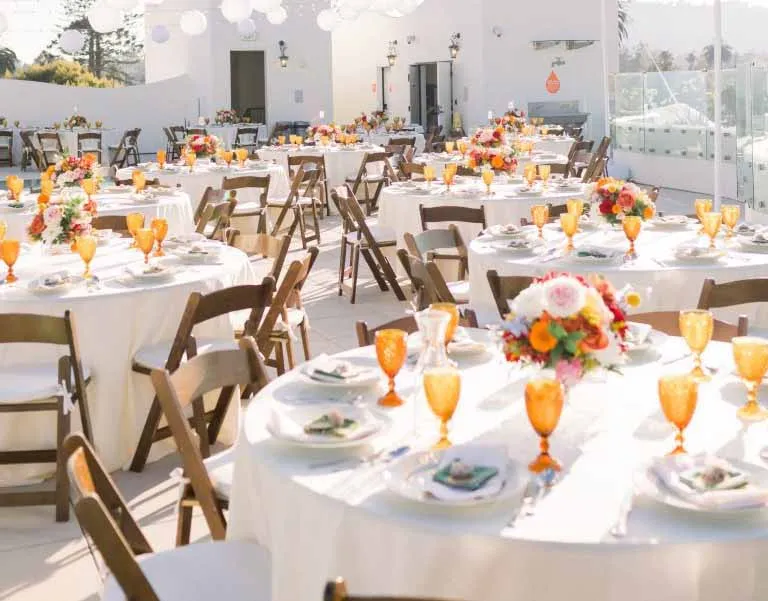
Balancing precise estimates with practical buffers prevents waste and service disruptions. Partnering with reliable rental companies further supports efficient planning.
How to Balance Between Overestimating and Underestimating Tableware?
Apply a standard 10% buffer for breakage and late arrivals, then adjust based on the event type and duration; long receptions might need a 15% buffer. Monitor menus with multiple courses to fine-tune buffer rates.
Why Is Reliable Rental Service Important for Avoiding Shortages?
An established rental company ensures consistent inventory, professional logistics, and rapid replacements. Event Rentals offers live inventory tracking and backup items to reinforce seamless execution.
How to Incorporate Sustainability and Eco-Friendly Tableware Options?
Opt for reusable porcelain, crystal, and linen over disposables. Incorporate compostable napkins or bamboo flatware to reduce environmental impact while lowering breakage rates.
Where Can You Find Quality Tableware Rental Services and Expert Advice?
Choose a rental partner with a comprehensive catalog, consultative support, and streamlined ordering processes for peace of mind and precise delivery.
What Should You Look for in a Tableware Rental Company?
Look for a broad inventory, plates, glassware, cutlery, linens, and serving dishes, with high-quality standards such as porcelain, crystal, and premium linen. Ensure they offer consultation services, on-site logistics, and flexible delivery/pickup windows.
How Does EventReady Support Accurate Tableware Estimation?
EventReady integrates a proprietary tableware calculator, live inventory monitoring, and expert consultations, generating customized reports that align every plate, fork, and glass with your guest count and menu.
How to Contact EventReady for Customized Tableware Solutions?
For a personalized quote or consultation, visit EventReady’s website to complete the website form, call their rental hotline, or email their event planning team for tailored recommendations.
FAQs
Q. How many plates should I order per guest for a sit-down dinner?
A. For plated dinners, estimate three plates per person—one each for salad, entrée, and dessert. Add a 10% buffer to accommodate breakage and last-minute additions.
Q. Why do buffet events need more plates than plated meals?
A. Buffets often require extra plates for seconds, side dishes, or dessert service. Plan for at least two plates per guest plus one extra plate per 10 guests.
Q. What’s the best way to calculate glassware for events with multiple drink options?
A. Break down the drink menu by type, wine, beer, cocktails, and estimate 1.5 glasses per guest per drink type, adding 10% extra for toasts and breakage.
Q. How can I prevent over-ordering tableware for a small event?
A. Use a tableware calculator or spreadsheet tailored to your event’s service type and guest count. Stick to a standard buffer of 5–10% and avoid inflating your estimates unnecessarily.
Q. Are reusable and eco-friendly tableware options available for rental?
A. Yes. Many rental companies now offer porcelain, glass, and metal alternatives to disposables, as well as compostable or bamboo options for more sustainable events.
Conclusion
Successful event execution depends on precise planning—and estimating tableware is no exception. From guest count and meal courses to venue size and event format, every detail should inform your numbers. Whether you’re renting or sourcing in-house, applying strategic buffer percentages and using tools like tableware calculators can dramatically improve accuracy and reduce waste. Thoughtful estimation ensures your guests enjoy seamless service, your vendors stay on schedule, and your event leaves a lasting impression for all the right reasons. With the right process and expert partners, every plate, fork, and flute will be exactly where it needs to be.

